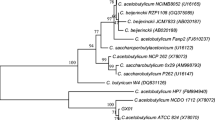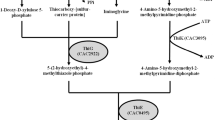Abstract
n-Butanol fermentation using Clostridium strains suffers from low titers due to the inability of the strains to tolerate n-butanol. The current study demonstrates a process to get high titer of n-butanol in a single batch mode from the renewable feedstock jatropha seed cake by employing Clostridium acetobutylicum. Chemical mutagenesis was done for improvement of the strain for better n-butanol tolerance and production. Optimization of the parameters resulted in 13.2 g L−1 of n-butanol in 120 h using acid-treated jatropha seed cake hydrolysate (7 % w/v) in anaerobic sugar medium. The process was scaled up to 15 L level, yielding 18.6 g L−1 of n-butanol in 72 h. The strain was found to be tolerant up to 30 g L−1 n-butanol under optimized conditions. The n-butanol tolerance was accompanied by over-expression of the stress response protein, GroEL, change in fatty acid profile, and ability to accumulate rhodamine 6G in the strain. The study has a significant impact on economically producing n-butanol from biomass.







Similar content being viewed by others
References
Alsaker KV, Paredes C, Papoutsakis ET (2010) Metabolite stress and tolerance in the production of biofuels and chemicals: gene-expression-based systems analysis of butanol, butyrate, and acetate stresses in the anaerobe Clostridium acetobutylicum. Biotechnol Bioeng 105(6):1131–1147
Atsumi S, Wu TY, Machado IM, Huang WC, Chen PY, Pellegrini M, Liao JC (2010) Evolution, genomic analysis and reconstruction of isobutanol tolerance in Escherichia coli. Mol Syst Biol 6:449
Baer SH, Blaschek HP, Smith TL (1987) Effect of butanol challenge and temperature on lipid composition and membrane fluidity of butanol-tolerant Clostridium acetobutylicum. Appl Environ Microbiol 53:2854–2861
Brynildsen MP, Liao JC (2009) An integrated network approach identifies the isobutanol response network of Escherichia coli. Mol Syst Biol 5:277
Desmond C, Fitzgerald GF, Stanton C, Ross RP (2004) Improved stress tolerance of GroESL-overproducing Lactococcus lactis and orobiotic Lactobacillus paracasei NFBC 338. Appl Environ Microbiol 70:5929–5936
Dunlop MJ (2011) Engineering microbes for tolerance to next-generation biofuels. Biotechnol Fuels 4:32
Ezeji TC, Qureshi N, Blaschek HP (2007) Butanol production from agricultural residues: impact of degradation products on C. beijerinckii growth and butanol fermentation. Biotechnol Bioeng 97:1460–1469
Ezeji TC, Qureshi N, Blaschek HP (2007) Bioproduction of butanol from biomass: from genes to bioreactors. Curr Opin Biotechnol 18:220–227
Goodarzi H, Bennett BD, Amini S, Reaves ML, Hottes AK, Rabinowitz JD, Tavazoie S (2010) Regulatory and metabolic rewiring during laboratory evolution of ethanol tolerance in E. coli. Mol Syst Biol 6:378
Isken S, de Bont JAM (1998) Bacteria tolerant to organic solvents. Extremophiles 2:229–238
Jang YS, Malaviya A, Cho C, Lee J, Lee SY (2012) Butanol production from renewable biomass by Clostridia. Bioresour Technol 123:653–663
Jones DT, Woods DR (1986) Acetone butanol fermentation revisited. Microbiol Rev 50:484–524
King AJ, He W, Cuevas JA, Freudenberger M, Ramiaramanana D, Graham IA (2009) Potential of Jatropha curcas as a source of renewable oil and animal feed. J Exp Bot 60:2897–2905
Kumar M, Gayen K (2011) Development of biobutanol production: new insights. Appl Energy 88:1999–2012
Lazaroaie MM (2009) Mechanisms involved in organic solvent resistance in Gram-negative bacteria. World Acad Sci Eng Technol 54:648–658
Lee SJ, Oh EK, Oh YH, Won JI, Han SO, Lee JW (2010) Increased ethanol resistance in ethanolic Escherichia coli by insertion of heat-shock genes BEM1 and SOD2 from Saccharomyces cerevisiae. Biotechnol Bioprocess Eng 15:770–776
Li J, Zhao JB, Zhao M, Yang YL, Jiang WH, Yang S (2010) Screening and characterization of butanol tolerant microorganisms. Letts Appl Microbiol 50:373–379
Liang Y, Siddaramu T, Yesuf J, Sarkany N (2010) Fermentable sugar release from Jatropha seed cakes following lime pretreatment and enzymatic hydrolysis. Bioresour Technol 101:6417–6424
Long S, Jones DT, Woods DR (1984) Initiation of solvent production, clostridial stage and endospore formation in Clostridium acetobutylicum P262. Appl Microbiol Biotechnol 20:256–261
Luo LH, Seo PS, Seo JW, Heo SY, Kim DH, Kim CH (2009) Improved ethanol tolerance in Escherichia coli by changing the cellular fatty acids composition through genetic manipulation. Biotechnol Lett 31:1867–1871
Makkar HPS, Aderibigbe AO, Becker K (1998) Comparative evaluation of nontoxic and toxic varieties of Jatropha curcas for chemical composition, digestibility, protein degradability and toxic factors. Food Chem 62:207–215
Makkar HPS, Becker K, Schmook B (1998) Edible provenances of Jatropha curcas from Quintana Roo state of Mexico and effect of roasting on antinutrient and toxic factors in seeds. Plant Foods Hum Nutr (Formerly Qualitas Plantarum) 52:31–36
Makkar HPS, Francis G, Becker K (2008) Protein concentrate from Jatropha curcas screw pressed seed cake and toxic and antinutritional factors in protein concentrate. J Sci Food Agric 88:1542–48
Nicolaou SA, Gaida SM, Papoutsakis ET (2010) A comparative view of metabolite and substrate stress and tolerance in microbial bioprocessing: from biofuels and chemicals, to biocatalysis and bioremediation. Metab Eng 12:307–331
Nishino K, Yamaguchi A (2004) Role of histone-like protein H–NS in multidrug resistance of Escherichia coli. J Bacteriol 186:1423–1429
Papoutsakis ET (2008) Engineering solventogenic clostridia. Curr Opin Biotechnol 19:420–429
Parekh M, Formanek J, Blaschek HP (1998) Development of a cost effective glucose–corn steep medium for production of butanol by Clostridium beijerinckii. J Ind Microbiol Biotechnol 21:187–191
Pfromm HP, Amanor-Boadu V, Richard N, Vadlani P, Madl R (2010) Bio-butanol vs. bio-ethanol: a technical and economic assessment for corn and switchgrass fermented by yeast or Clostridium acetobutylicum. Biomass Bioenergy 34:515–524
Qureshi N, Saha BC, Cotta MA (2007) Butanol production from wheat straw hydrolysate using Clostridium beijerinckii. Bioprocess Biosyst Eng 30:419–427
Qureshi N, Ezeji TC, Ebener J, Dien BS, Cotta MA, Blaschek HP (2008) Butanol production by Clostridium beijerinckii. Part I—use of acid and enzyme hydrolyzed corn fiber. Bioresour Technol 99:5915–5922
Qureshi N, Saha BC, Dien BS, Hector RE, Cotta MA (2010) Production of butanol (a biofuel) from agricultural residues: part I—use of barley straw hydrolysate. Biomass Bioener 34:559–565
Qureshi N, Saha BC, Ronald EH, Bruce D, Stephen H, Siqing L, Loren I, Michael JB, Gautam S, Michael AC (2010) Production of butanol (a biofuel) from agricultural residues: part II—use of corn stover and switchgrass hydrolysates (2010). Biomass Bioenergy 34:566–571
Rakshit KD, Darukeshwara J, Rathina Raj K, Narasimhamurthy K, Saibaba P, Bhagya S (2008) Toxicity studies of detoxified Jatropha meal (Jatropha curcas) in rats. Food Chem and Toxicol 46:3621–3625
Ramos JL, Duque E, Gallegos MT, Godoy P, Ramos-Gonzalez MI, Rojas A, Teran W, Segura A (2002) Mechanisms of solvent tolerance in Gram-negative bacteria. Ann Rev Microbiol 56:743–768
Ranjan A, Khanna S, Mohalkar VS (2013) Feasibility of rice straw as alternate substrate for biobutanol production. Appl Energy 103:32–38
Reyes LH, Almario MP, Kao KC (2011) Genomic library screens for genes involved in n-butanol tolerance in Escherichia coli. PLoS One 6:e17678
Samuelov NS, Lamed R, Lowe S, Zeikus JG (1991) Influence of CO2–HCO3 + levels and pH on growth, succinate production and enzyme activities of Anaerobiospirillum succiniciproducens. Appl Environ Microbiol 57:3013–3019
Sardessai Y, Bhosle S (2002) Tolerance of bacteria to organic solvents. Res Microbiol 153:263–268
Sikkema J, De Bont JA, Poolman B (1995) Mechanisms of membrane toxicity of hydrocarbons. Microbiol Rev 59:201–222
Tasun K, Chose P, Ghen K (1970) Sugar determination by DNS method. Biotechnol Bioeng 12:991–992
Tomas CA, Beamish J, Papoutsakis ET (2004) Transcriptional analysis of butanol stress and Clostridium acetobutylicum. J Bacteriol 186(7):2006–2018
Tomas CA, Welker NE, Papoutsakis ET (2003) Overexpression of groESL in Clostridium acetobutylicum results in increased solvent production and tolerance, prolonged metabolism, and changes in the cell’s transcriptional program. Appl Environ Microbiol 69:4951–4965
Torres S, Pandey A, Castro GR (2011) Organic solvent adaptation of Gram positive bacteria: Applications and biotechnological potentials. Biotechnol Adv 29:442–452
Volherbst- Schneck K, Sands JA, Montenecourts BS (1984) Effect of butanol on lipid composition and fluidity of Clostridium acetobutylicum ATCC 824. Appl Environ Microbiol 47:193–194
Zingaro KA, Papoutsakis ET (2013) GroES overexpression imparts Escherichia coli tolerance to i-, n-, and 2-butanol,1, 2,4-butanetriol and ethanol with complex and unpredictable patterns. Metab Eng 15:196–205
Acknowledgments
The authors gratefully acknowledge the encouragement and support of Reliance Life Sciences Pvt. Ltd. in carrying out the research work.
Author information
Authors and Affiliations
Corresponding author
Rights and permissions
About this article
Cite this article
Isar, J., Joshi, H. & Rangaswamy, V. n-Butanol Production from Acid-Pretreated Jatropha Seed Cake by Clostridium acetobutylicum . Bioenerg. Res. 6, 991–999 (2013). https://doi.org/10.1007/s12155-013-9332-5
Published:
Issue Date:
DOI: https://doi.org/10.1007/s12155-013-9332-5




